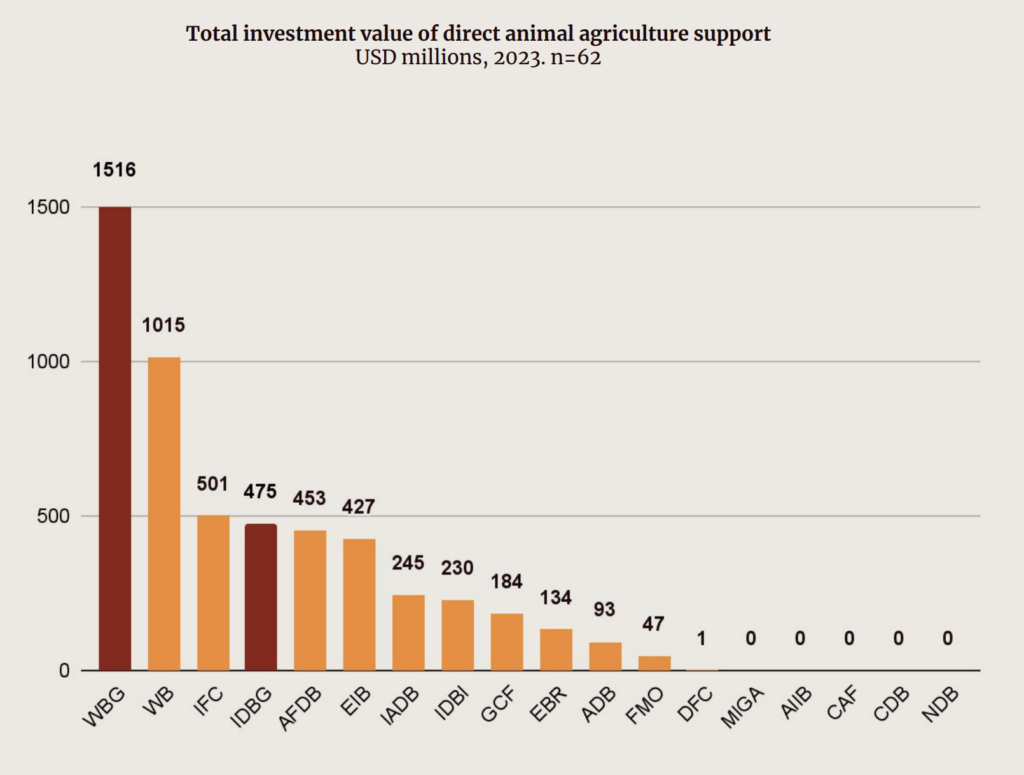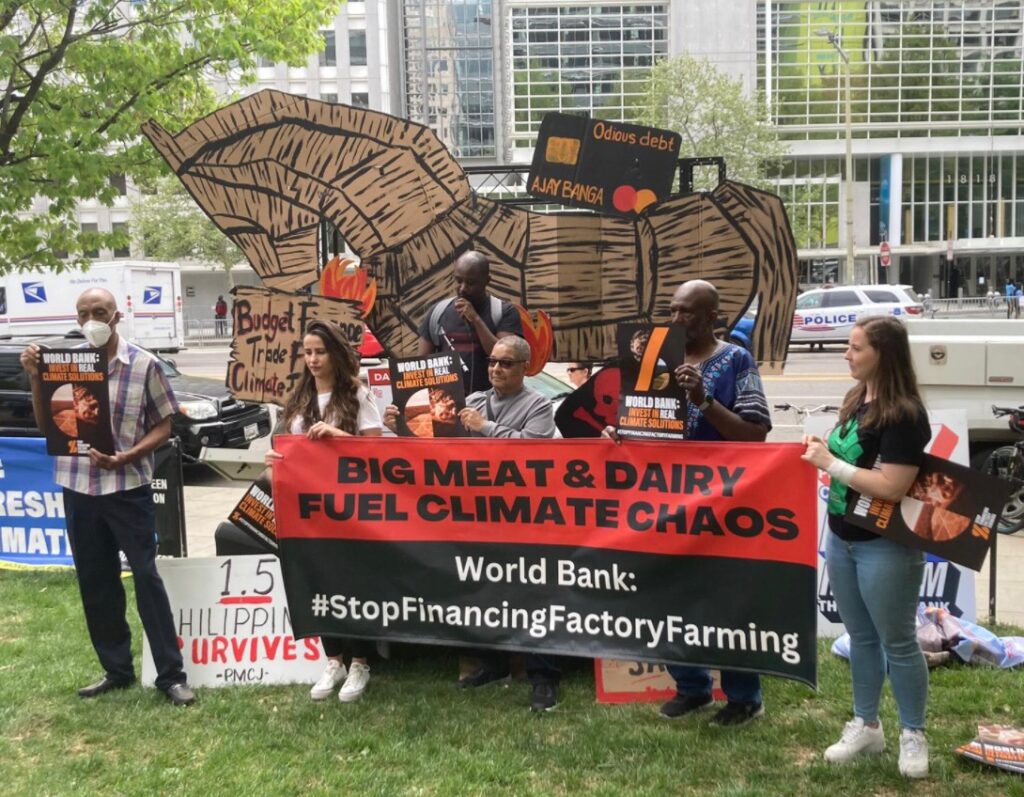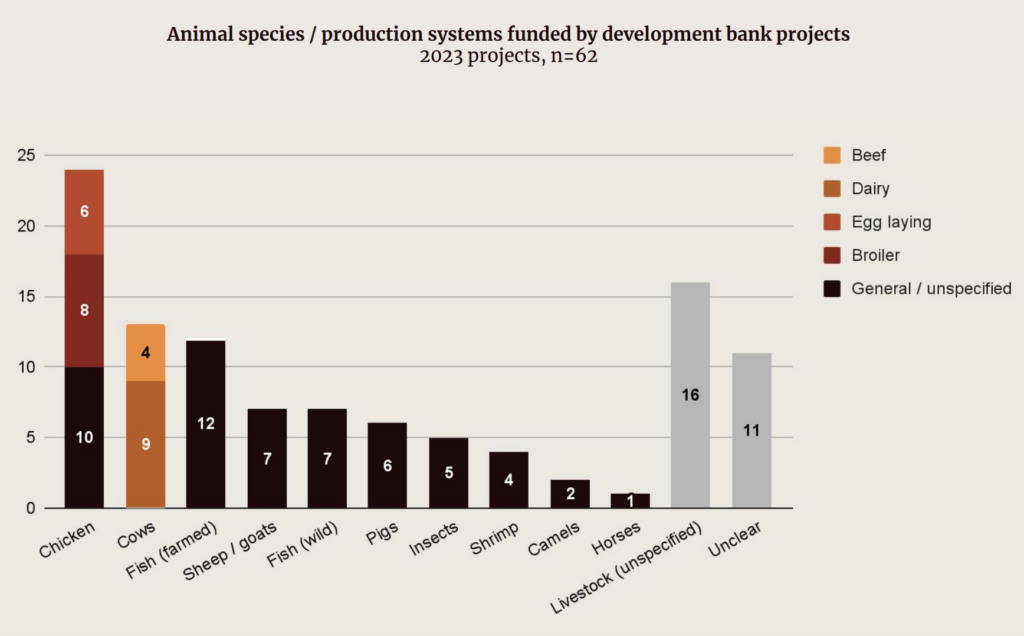World Bank, UN Climate Fund Among Public Banks That Invested $3.3B in Factory Farming in 2023
5 Mins Read
Over a dozen development banks including the World Bank and the UN Green Climate Fund poured billions into animal agriculture last year, going against their own recommendations.
The UN’s Green Climate Fund (GCF), the World Bank Group, and the EU’s European Investment Bank (EIB) are among a group of development banks that have been pumping money into meat and dairy production – and mostly factory farming – despite the sector’s outsized impact on the planet.
They’re among 16 development banks that have funnelled billions for the expansion of industrially farmed meat and dairy as well as animal feed in the Global South and low-income countries, according to new analysis by Stop Financing Factory Farming, a coalition of campaign groups including Friends of the Earth US, Feedback Global, World Animal Protection, and the International Accountability Project.
In 2023 alone, these banks invested $3.3B in animal agriculture, 77% of which went to factory farming systems. This was supplemented with another $3.4B mobilised from other public and private investors.
“Livestock production can play a role in meeting the nutritional and economic needs of the populations whom development banks serve,” the report said.
“However, the decades-long industrialisation and globalisation of the sector has driven the overconsumption of animal-based foods in higher-income countries, while the diversion of resources toward feeding animals instead of humans has exacerbated food insecurity among populations in lower and middle-income countries who should be the beneficiaries of development banks’ support.”
World Bank Group a major financier of livestock farming

Industrial animal agriculture involves practices and establishments like concentrated animal feeding operations, large-scale slaughtering plants, and reliance on monocropping to produce animal feed. These are linked to deforestation, biodiversity loss, water pollution, land degradation, and high greenhouse gas emissions – and that’s before you consider the unethical treatment of animals.
The financial instruments analysed include funding for construction or expansion of breeding, rearing and/or slaughter operations, as well as investment into large-scale soy, corn or cereal production, fertiliser and seed manufacturing, irrigation system construction, animal-derived food production, and logistics.
Stop Financing Factory Farming found that of all projects financed by the 16 development banks in 2023, at least 2% directly supported animal agriculture, and another 8.4% did so potentially.
The World Bank Group – which comprises the World Bank, the International Finance Corporation (IFC), and the Multilateral Investment Guarantee Agency – invested $1.5B in 26 projects directly supporting livestock farming (26) last year (including $750M for factory farming), and 15 of these were funded by the IFC alone.
This runs counter to the World Bank’s own narrative. It produced a landmark report in May that called on governments to redirect agrifood subsidies away from livestock producers and towards low-emission foods, and encouraged greater adoption of alternative proteins like plant-based, cultivated and fermentation-derived foods.
The IFC has pumped $1.6B in the industrial farming sector since 2017. This includes a $47.3M loan to build a multi-storey pig farm in China, a $23M investment in India’s Srinivasa Farms to support its broiler and breeding expansion, and $50M to expand the pork and poultry operations of Ecuadorian producer Pronaca. It has also loaned $200M to agrifood giant Louis Dreyfus Company for the purchase of deforestation-linked soy and corn mostly for factory farms.
This is why it has been facing calls to phase out its support of animal agriculture operations. The World Bank member has also committed to make all of its new investment operations from July 1 next year aligned to the goals of the Paris Agreement.

Public disclosures under scrutiny
The Inter-American Development Bank Group funded 14 livestock-linked projects last year, totalling $1B in investment (an average of $75.5M). The EIB, meanwhile, backed six such projects with $427M, with an average investment of $71.2M per project.
And while the average proportion of portfolios supporting animal agriculture was 3.1%, this share was higher for the African Development Bank (7.1%), IDB Invest (5.7%), and the GCF (12.5%), which is the world’s largest climate fund.
Sub-Saharan Africa had the highest number of animal agriculture projects financed by development banks, with 22 projects (36% of the total) receiving $1.4B. Latin America and the Caribbean (17 projects) were next, bagging $691M, followed by Europe and Central Asia, where 11 projects were supported by investments totalling $603M.
There was an equal split between public and private sector support for the meat and dairy industry, the difference being that government-funded projects were generally higher in value and had a greater impact on animal agriculture systems, while the latter largely supported the operations of single companies.
This capital most frequently supported systems that raised chickens for meat or eggs, with beef, fish, sheep, goats and pigs also commonly receiving financial support. And only 6.7% of projects supported by these funds were for non-industrial purposes, with public disclosures unclear about 16.7% of them.

These efforts highlight the disconnect between development banks’ investments and climate targets. Animal agriculture is responsible for up to 20% of global greenhouse gas emissions, and 57% of the food system’s climate footprint. It also takes up 80% of the world’s farmland and a third of its freshwater supply, but only provides 17% of our calories and 38% of protein.
The Stop Financing Factory Farming campaign is therefore calling on development banks to end their support of factory farms and instead promote farming practices that benefit the environment, biodiversity, and local communities.
That said, the EIB claimed that three of its six projects cited in the report were “entirely unrelated to animal production”, according to Sentient Media, but a member of the International Accountability Project explained that those projects were included because the EIB’s disclosures were “among the worst” of all the banks in terms of transparency, and thus “one of the most challenging institutions to analyse and hold accountable”.
Stop Financing Factory Farming has now launched Factory Farming Finance Tracker, a tool covering over 27,000 projects to highlight development banks’ role in funding the expansion of the livestock industry and subsequently the climate crisis.



